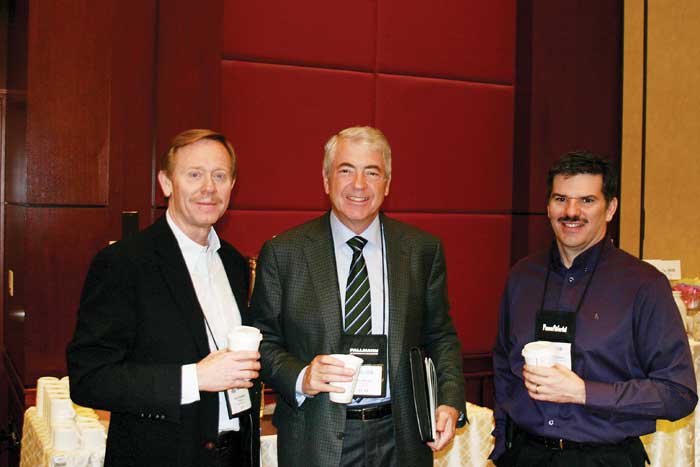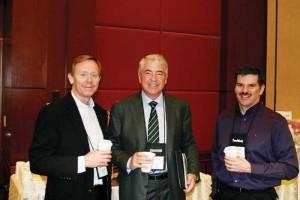
More than 300 industry professionals, including representatives from 25 wood products producer companies, 65 exhibitor companies and 50 speakers, converged on the Omni Hotel at CNN Center here March 1-2 for the third Panel & Engineered Lumber International Conference & Expo (PELICE).
The event, which is held every other year, was hosted by Panel World magazine and Georgia Research Institute.
PELICE included eight keynote speakers who addressed the entire attendance body (four each morning), and 14 breakout sessions, each with multiple speakers who addressed a range of technologies and issues in the structural and non-structural wood products industries.
“This is really the only conference and expo that draws significantly from both the structural and non-structural wood industries, and it allows everyone to gauge the big picture as well gain specifics on improving their own operations,” says Rich Donnell, co-chairman of PELICE and editor-in-chief of Panel World. “The building products industry is still relatively soft, but it is percolating, and this event was certainly more upbeat than 2010 when the economy had flatlined.”
Mercer University Ph.D. professor of economics Roger Tutterow turned heads at the opening morning keynote session when he told the audience that according to classic economic indicators, the “Great Recession” economic downturn of 2008 had ended in mid 2009. However, he cautioned, the lack of improvement in markets felt by many in attendance at PELICE is symptom of the recovery, which is expected to be long and slow.
As an example, he noted that 8.8 million jobs were lost in 2008-09: “We were losing 700-800 thousand jobs a month back then, and we’re very gradually digging our way out,” Tutterow said. He said the employment picture likely won’t truly improve until 2014.
Noting the 80% drop in housing starts from 2006-2009, Tutterow said that housing is now at a 650,000 starts annualized rate, with multi-family construction leading the way. Single-family home construction is also doing better, but coming off such a huge drop it will likely be 2015 before housing starts get back to normal levels. Tutterow also cautioned that while energy states have seen the best employment numbers and recovery data, rising energy prices could pose a threat to such a slow economic recovery.
Lynn Michaelis, president of Strategic Economic Analysis and RISI executive adviser, pointed to a recovery, but noted that the difference in this one is that despite extremely low interest rates, the housing market hasn’t responded thanks to the excessive stock on the market.
Michaelis said the decline in housing starts from 2.1 million to below 500,000 “was a depression, not a recession.” He pointed to a home pricing reduction of 22%, a massive decline in home equity from $13 trillion in 2005 to $6 trillion in 2011, and said more than 30% of mortgage holders are in a negative equity position. “Housing used to lead the recovery, but not this time,” he added. “We’re in an inventory correction period, and we must eliminate excess vacant housing inventory to get a sustained recovery.”
Michaelis presented a new Housing Model that includes among other things an analysis of excess vacant stock, a situation which he said is improving, albeit very slowly. Vacant stock declined by only 200,000 units in 2011 and will remain a drag in 2012, he said, followed by improvement, but tied to hidden inventory for single family foreclosures.
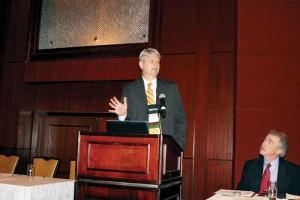
The RISI view is that falling home ownership rates and tough lending standards will boost multi-family starts, while single family starts as a percentage of total starts continues to decline during the recovery, which he said will see multi and single housing starts approaching 1.5 million as of 2015.
Curt Stevens, newly named CEO of Louisiana-Pacific, noted that LP’s business (heavy to OSB) is down 75% since the demise of the housing market. But Stevens emphasized that LP produces a financial plan every five years and that it’s not put on the shelf, and that this financial focus and planning is imperative to putting LP in a position to take advantage of a building products recovery, and to maintain itself even if the economy continues to drag. Stevens said LP constantly analyzes its supply chain from the stump to the customers, pinpointing pinch points. He said LP has expanded internationally in South America and continues to examine new markets.
Keynote speaker John Murphy, president of Murphy Co. and former president of APA—The Engineered Wood Assn., noted that the PELICE event “brings knowledge and value to this industry, and here we can see all our combined strengths.” Murphy reviewed the growth of Murphy Co. into a multi-plant manufacturer of hardwood plywood, LVL, softwood plywood and veneer.
Looking at trends in industry, Murphy said an increased global impact with more transnational ownership and more investment from North America to South America requires North American producers to keep a sharp eye on costs. Closer to home, Murphy said public timber access remains a huge issue for Western U.S. producers.
“Public timber access has a huge implication for overall rural economic health and in maintaining the infrastructure and roots of this industry such as logging,” he said, adding, “It’s vital that we join forces as an industry to protect our interests.” Though the current economic downturn “is a challenge that we’ve been given to face together, I’m more optimistic these days, and we need to remember our products are indispensable to the economic recovery,” he said.
Another keynoter, Grady Mulbery, vice president of Composite Manufacturing at Roseburg Forest Products, spoke on an industry in transition. He noted that since 2000, the ownership pattern has moved from public to private, the business model from integrated to non-integrated, raw material cost pressure from low to high and U.S. regulation from moderate to intrusive.
There has been considerable restructuring in the asset base, Mulbery said, noting, for example, that Roseburg today operates four particleboard plants, compared to six in 2007, while continuing to operate four laminating facilities. Mulbery said that as of 2011 the top five particleboard producers in North America represent 65% of production, and the top five in thermally-fused melamine represent 75%.
Keynoter Pete Stewart, president and CEO of Forest2Market, addressed the new bioenergy raw material demand and impact on panel and engineered wood product manufacturers. He noted that to meet green energy targets, the UK must import 20 million tons of pellets annually by 2020, and that if one-third of this is sourced from the Eastern U.S., then 8-12 new pellet plants are needed. He said the total EU demand is expected to be 120 million tons by 2020, more than 10 times the world’s installed manufacturing capacity. However, Stewart doesn’t anticipate a “techtonic shift in pricing, but a slow march over time.”
He said that on balance over the next 10 years, about 9% of additional U.S. renewables (not already associated with pulp and paper or currently existing) will come from wood, putting total domestic wood fuel demand at 125 million green tons.
Dr. Hans Fechner, CEO of Siempelkamp, traveled from headquarters in Krefeld, Germany to deliver one of the keynote presentations. He noted that the company started 128 years ago with the production of direct heated steam press platens and supplied hot presses to several industries, including plywood. The company began exporting plywood presses and equipment to North America in 1931.
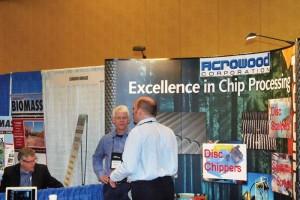
Fechner reflected on Siempelkamp’s development of the continuous hot press in the 1980s, and today more than 260 ContiRoll presses have been sold, and the product is in Generation 8, offered in three size ranges with with performance options geared to the end user. He also reviewed the company’s continuous and ongoing expansion of the product spectrum toward total plant supply. He said the company continues to expand globally and look at new industries such as bioenergy.
Cole Martin, sales manager, Dieffenbacher, in his keynote speech asked the question why isn’t more particleboard used in North America. “In most countries worldwide, particleboard is the most significant wood product of them all,” Martin said. “Despite this particleboard is a widely underrated product.”
He noted advantages of particleboard over MDF such as lower wood consumption, lower density, lower cost per sq. ft. for furniture, less resin consumption, possible use of recycled wood, excellent surface quality for added value applications and sufficient properties for many furniture applications.
Martin said raw material is available in North America and there are millions of tons of untapped resources. He pointed also to an industry that encompasses mostly older particleboard plants, and that potential investment is high.
“There is a great need to start looking for ways to increase usage and at the same time lower production costs,” he said. He reviewed Dieffenbacher’s line of particleboard production machinery, and the company’s manufacturing and support services in North America.
Breakout Sessions
During a technical session looking at the changing world of plywood production and challenges going forward, plywood industry veteran Dick Baldwin, executive vice president and general manager of Wood Resources Southeast, noted the challenges plywood producers face with global competition.
In addition, the changing nature of the industry, with more plywood plants functioning as stand-alone mills instead of part of a vertically integrated forest products company, has forced mills to be more competitive, he said.
Baldwin challenged plywood producers to go back to the plywood industry’s “entrepreneurial roots” by looking at the unique characteristics of plywood “and taking those characteristics to the marketplace.”
He advised producers to “do away with the current structural panel mentality,” to “restructure your business model and performance expectations to better appeal to your stakeholders,” to “redefine the leadership style that represents the culture of organization” and to “recognize that plywood is a global business.” Though plywood capacity has dropped, the industry is far from dead, Baldwin said.
Scott Weatherford, CEO of ATCO Wood Products, Fruitvale, British Columbia, addressed how his independent veneer producer operation was able to reinvent its business model to find success during the challenging environment of recent years.
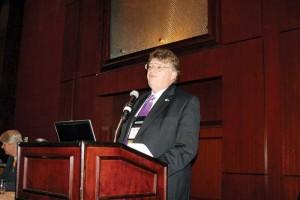
The 53-year-old business operates softwood veneer, woodlands/forestry and shortline railroad divisions, and its products range includes softwood veneer, logs, chips, biomass and landscape materials. The company sells to primarily Northwest customers in virtually all plywood market segments.
Following the collapse of the market in 2007-2009, ATCO changed it approach from a “produce what we want and sell what we make” mentality to a “customized veneer model” that encompasses an intense focus on customer needs (beginning in the woods), focus on quality, cost control and emphasizes employee engagement.
The newest development in the mill, which is still in process, is automatic grading of green veneer. The project uses dry veneer grading technology to grade green veneer between the lathe and the clipper. As the veneer comes off the lathe and down the trays, it passes through the scanner as a ribbon. The scanner examines the ribbon, electronically clips the veneer, and assigns a grade to each piece. This is similar to the dry veneer grade scanning with the added step of analyzing and splitting the ribbon first.
“It allows us to better understand the grade characteristics of our veneer and will help us to produce the specific grade profile that our customers desire,” Weatherford said.
On the back end, the company provides custom packaging for different customers. “While things such as plastic strapping or metal strapping, or two bands versus three bands seem subtle, we believe they offer the opportunity to distinguish ourselves to our customer,” Weatherford said.
Citing service issues so frequently attributed to the railroads, ATCO in 2010 acquired the shortline railroad that serviced its mill. “We saw this as an opportunity to improve the service to our mill, and in turn improve the delivery performance to our customers,” Weatherford said.
He said at the end of the day, however, it comes down to the performance of the ATCO team, which “breathes life into this model. They have a constant attention to every detail, and are constantly communicating up and down the supply chain to produce the product that the customer needs.” As a result, Weatherford said over the past two years they’ve seen improved customer loyalty, improved competitive advantage, improved quality, increased demand, and improved value realization for their wood.
Gary Heroux, vice president of product acceptance with Composite Panel Assn., addressed the challenges facing the composite board industry. He noted that the industry is coming out of its longest and deepest decline ever, with domestic panel shipments flat for the past three years but expected to be modestly up this year. Heroux cited cost pressures such as mostly weak consumer markets, mill capacity utilization rates at historic lows, competition for high quality wood fiber, rising adhesive costs, EPA Boiler MACT compliance costs, CARB and EPA product emissions regulations and offshore imports. CPA is heavily engaged in these developments.
Heroux also addressed CPA’s new Eco-Certified Composite (ECC) sustainability standard, which is granted on a manufacturing facility basis, and which serves the entire value chain. Only panels that are CARB compliant or exempt from CARB are eligible.
A plant must conform to at least three of five specific environmental criteria to qualify for ECC. The five criteria include: 1) Carbon Footprint—demonstrating that the panel’s carbon store offsets its carbon footprint cradle-to-gate. Each facility will use the CPA Carbon Calculator to determine if its panels perform as a carbon sink resulting in overall net carbon storage. 2) Local and Renewable Resource—at least 85% of wood fiber used is sourced with 250 miles of the plant. 3) Recycled or Recovered—use of a minimum of 75% recycled or recoverd wood fiber or use of at least 50% recycled or recovered wood fiber and a minimum of 5% post-consumer wood fiber. 4) Sustainability—97% of wood fiber furnish is either converted into panels or re-utilized as a valued product. 5) Wood Sourcing—assessment is made of 100% of wood fiber used and the facility must conform to either FSC Controlled Wood Standard, or FSC Chain of Custody Standard or SFI Fiber Sourcing Requirements.
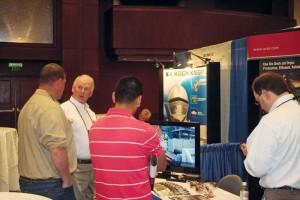
Steve Zylkowski, director, Quality Services Div., APA—The Engineered Wood Assn., noted that the recession in Europe and the winding down of fiscal stimulus do not bode well for U.S. growth during the first half of 2012. He said most U.S. housing forecasts (single family and multifamily) are in the range of 700,000, but with an average 25% housing starts hike in 2013 to the 880,000 range, while recognizing that many headwinds persist.
Looking at global markets, he said the U.S. and EU are at risk but other export markets appear to be expanding. North American panel exports to Japan for example in 2011 increased by nearly 52% in 2011 from 2010 to more than 277MMSF, and Russia’s instake jumped 39% to more than 153MMSF. However, Zylkowski pointed out that the post Tsunami plywood export surge to Japan is over.
Wade Camp, economist at RISI, said U.S. OSB capacity at 13 billion SF is down 22% from the 2007 peak, and plywood capacity is at an all time low of 10 billion SF, down 50% from 2000. He said that since 2000, OSB prices have tracked below total cost 40% of the time and that OSB profits generally only occur during periods of market disruptions. He added that plywood prices spend less time below total cost levels as producers are more disciplined with supply and that plywood capacity is reaching equilibrium with demand.
Several speakers addressed the future of engineered lumber. Dave Parker, CEO of StrongWood Technologies, noted that while ELPs have a small share of the structural lumber market, lower cost second generation ELPs may accelerate market penetration providing they offer technical superiority. Parker cited his own StrongWood technology as a breakthrough in manufacturing costs across a broad spectrum of strength grades.
Mike St. John, vice president of sales and marketing for Pacific Woodtech, said, “The stage is set for an ELP growth spurt,” thanks to better utilization, green certification programs making it easier for ELPs to conform than solid sawn products, plus log scarcity that will find engineers and builders looking to ELPs more often.
St. John emphasized the key to increasing ELPs’ current 7% share of the lumber market is reducing manufacturing costs, and noted that ELPs’ manufacturing processes offer more flexibility than solid sawn production. Also, he added that a smaller environmental footprint makes ELPs more adaptable to limited wood baskets.
Taking a long projection window and assuming 2.165 million housing starts in 2040, St. John projected a strand lumber 56% share (63.5BBF) of the total lumber and engineered wood demand in North America, with softwood lumber at 38%, followed by I-joist at 4% and LVL at 2%. As of 2010, according to St. John, strand lumber accounted for less than 1% of the demand, with softwood lumber at 96%.
William Bolduc, structural engineer, Keymark Enterprises, cited advantages of ELPs such as greater design capability over traditional lumber, and also pointed to disadvantages such as higher cost per volume than lumber, substitution issues and construction complexities. However, growing implementation of ELPs will be directly related to building plan specifications, design problem solutions, computer software programming and ELP manufacturer reliability and support, he said.
Tomas Joscak, CEO of Dascanova, promoted a new 3D density wave arrangement board, citing extreme raw material savings and no loss (and possible gain) in mechanical properties. Dascanova technology, stationed between the prepress and continuous press, performs mat modification using heat energy and selective pre-hardening.
Dave Bueche, marketing representative for Hoover Treated Wood Products, spoke on fire-retardant treated structural wood panels. He provided an historical evolution of FRTS, impact on building codes and design methodologies, end uses and application benefits.
Equipment companies representatives were also a major part of the sessions. Seven speakers addressed various issues and new technologies in resins and adhesives. Eight speakers focused on air emissions systems. Equipment representatives also spoke on veneer and plywood technologies, board production technologies, energy technologies and production enhancements.

